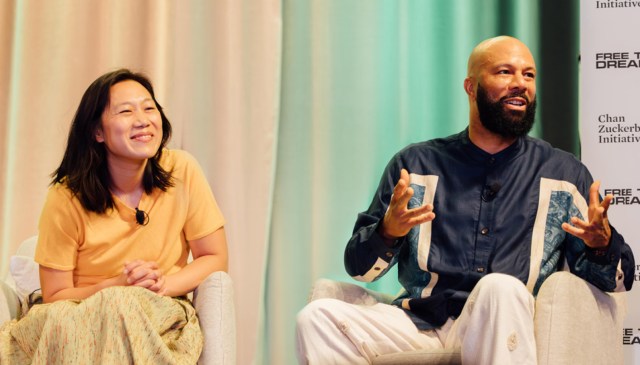December 18, 2019 · 6 min read
Fast Company: How Technology Can Amplify Great Teaching
How CZI is Working with Teachers to Support Student Learning
This piece was published in Fast Company on December 18, 2019.
Great teachers have always used all the tools available to them to better understand where a student is at and how to push them forward in their learning. In today’s busy classrooms, technology has the potential to be another powerful resource in a teacher’s toolbox to help them tailor their instruction to meet the distinct needs of every student. When applied with the right training and support, technology can help teachers build deeper real-world relationships and better meet the diverse needs of the more than 20 students they work with in the average classroom.
Technology is not a magic wand. It is just a tool—a powerful one—that can amplify good teaching. All of us know that good teachers make a huge difference in a student’s life. I know this firsthand because a teacher adopted my father and set him on the course to college. There are countless stories like this, and the research backs it up: learning, especially for K-12 students, is a very interpersonal process.
As many of us have fortunately experienced, the teacher who really sees students, believes in their potential, and has the time and knowledge to support their development can change their entire trajectory in school. But we have more work to do to ensure that teachers have the resources they need to use technology in their classrooms.
In recent years, access to high-speed internet in classrooms across the country has dramatically increased and finally caught up to other sectors. Thanks to organizations such as EducationSuperHighway, which we’ve supported at the Chan Zuckerberg Initiative, the number of students with broadband access in their classrooms increased from 4 million to 46 million in just seven years.
So how can this access and new technology amplify good teaching and ensure it translates to better student learning outcomes?
Great teachers help students make connections—to show them why learning matters to them. A teacher equipped with technology can access a trove of high-quality, enriching content that brings concepts to life. This access can be transformational for any student, and especially for those whose schools do not have certain specialists on staff or are too far away for a field trip to a local museum. Reading about Jupiter’s size is one thing, but seeing a picture of it compared to Earth is another. Watching a video from NASA of Jupiter’s moons traversing the giant planet is awe-inspiring. And on the frontier are virtual reality simulations that make immersive experiences accessible.
Technology can help teachers better tailor their instruction to meet students where they are and build even deeper relationships with their students. Rather than poring over homemade spreadsheets and waiting for year-end tests that provide too little information too late, tech-savvy teachers are analyzing dashboards that give them timely, granular insights into each student’s understanding and gaps. This data helps teachers to determine whether a student has grasped a critical concept and is ready to advance to the next level or needs additional support.
The benefits of faster and more frequent feedback are both intuitive and profound: Imagine asking a child to learn to play basketball by taking a shot, then waiting a week (or until the end of a semester) to find out if they made it. This efficiency allows teachers to spend more time building the relationships and connections that are critical for student development.
In the Pasadena Independent School District, teachers are using technology to more deeply engage their students. They meet with students regularly in mentoring sessions to discuss their academic progress, set goals, and develop an action plan. These teachers are among the thousands of educators nationwide that are using an initiative Chan Zuckerberg has worked on called the Summit Learning Program and its online platform to develop a more holistic perspective of how students are doing across classes, support student learning, and receive input from students on what they want to talk about in advance of one-on-one mentoring sessions. The Summit platform is the result of collaboration and constant iteration between learning scientists, teachers, and our technology team.
Thus, technology allows research on the importance of teacher-student relationships to translate into a part of the school day. Technology helps the hundreds of schools that already use the platform to adopt this more quickly. And technology helps support training for thousands of teachers on how to do this mentoring well. Through these integrated efforts, Pasadena 7th-graders who were the furthest behind made a 17% gain on the state math assessment and a 20% gain in reading.
Technology is not only transforming the way that teachers teach and students learn; it is also transforming the way that educators themselves learn and collaborate. Gone are the days when teachers operated in isolation behind closed classroom doors. A biology teacher in rural Iowa, for example, can now benefit from online learning communities to connect with their peers planning similar lessons.
Sadly, for most schools in America, the introduction of technology into the classroom remains a work in progress. An Education Week survey of teachers found that school systems often struggle to keep pace with constant technology upgrades; many teachers said their school does not provide enough training and support. Yet the vast majority of teachers still believe in the potential of technology and want to use technology in their classrooms. They just need more help figuring out how.
Inspiring stories are all around us about the practical application of technology in classrooms where it is helping teachers better support student learning. We must continue to validate these stories with research to help us understand not just what works, but where and why. We should ask tough questions about the impact of technology in the classroom—and the ethical and technical safeguards necessary to protect students’ personal information.
But we can’t just invest in the tools teachers use; we must invest in and trust the teachers themselves. They are—and always will be—at the heart of student learning, and, ultimately, they equip students with the knowledge and skills needed to successfully navigate school and life. Any technology investment we make must be led by, and reflect, what good teachers know and need.
###
Sandra Liu Huang leads the Education Initiative, product and design at the Chan Zuckerberg Initiative, focused on ensuring every student gets an education that meets their needs and supports every aspect of their development.





